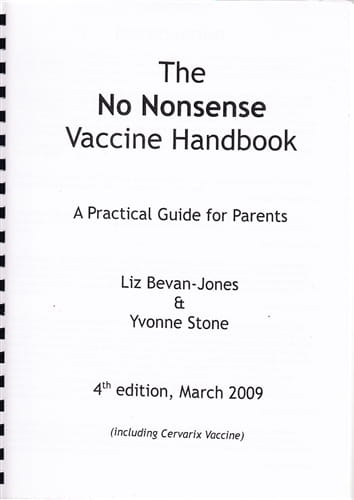This is the fourth edition of this very popular and useful publication, published in March 2009 and it includes the Cervarix Vaccine.
Yvonne Stone and Liz Bevan-Jones trained as homeopaths at the College of Homeopathy in London, qualifying in 1996. Both of them trained and have practised as State Registered Nurses. Before becoming interested in homeopathy, Yvonne worked as a certified midwife for 15 years; and Liz as a district nurse.
They originally collected together the material in this handbook to inform a Vaccination and Childhood Disease Support Group for parents and families, which they set up in 1999. The information presented here is intended for the use of parents - to enable them to make informed vaccine and health choices for their children. You have Liz and Yvonne's permission to photocopy any of the material in this booklet and pass it on to friends, families or anyone else who might find it useful.
Reprinted with the permission of The ARH (from 'Homeopathy in Practice' Journal, Spring 2005 edition). Reviewed by Patty Hemingway MARH.
This is a collection of information about vaccination, alternative prophylaxis, and the treatment and course of the childhood diseases covered. It presents a thorough consideration of the nine vaccinations offered to children, and also discusses the chickenpox vaccine used in the US alongside MMR, which may become included in the vaccination programme in this country. It is all the more valuable as a resource for homeopaths and patients alike because the material it contains was collected to inform discussion in the Vaccination and Childhood Disease Support Group, which the authors set up in 1999.
Each section is a series of stand-alone factsheets which present information about the vaccines and their side-effects, the disease and how to treat it using homeopathic remedies. With the authors' permission, these individual sections could usefully be copied and given to patients as required.
The authors are clearly aware of what parents need to know to be able to successfully use homeopathy as an alternative to conventional medicine in treating childhood illnesses, and they include useful sections on the treatment of fevers, diarrhoea, coughs, sore throats, wounds, burns and fevers. The clear information about what to look for and how to determine the right remedy and dosage is succinct and comprehensive and will, I am sure, give parents confidence to treat their children with homeopathy. These guidelines could also be an extremely useful reference for homeopaths, either in training or if they lack experience treating children.
I thought I had read pretty much every book available on the problems with, and homeopathic alternatives to, vaccination, but I still found new and useful information, clearly presented and ready for use in my consultations with parents anxious to do the right thing. For example, rubella is described as a vaccine with numerous side-effects, and of little or no value to the child, but the disease, if contracted by pregnant women can have devastating consequences for the unborn child, and therein lies the dilemma for responsible parents. The authors, however, point out that after the initial decline in cases of rubella after the vaccine was introduced in 1988, there was an increase from 1993, in men at college, and in pregnant women. So, the statistics would seem to imply that the immunity conferred by vaccination is not permanent, and that despite vaccination, incidences of the disease in pregnant women are not decreasing. This would suggest there has to be another way to resolve the dilemma, and the No Nonsense Vaccine Handbook provides some suggestions. Since the disease itself confers life-long protection, then it is, say the authors, 'far better for a young girl to catch Rubella naturally', and perhaps we should be testing young women for immunity prior to getting pregnant and then offering the vaccination selectively.
The book is extremely easy to use for quick reference, and the facts and figures given are from published research. It may be important for a parent to know, for example, that 'Children between the ages of 5 and 15 years have virtually no risk of contracting Meningitis C'. Or that 'there is concern that using this vaccine [Meningitis C] will cause other forms of Meningitis [principally B] to arise ... There is no vaccine for Meningitis B' and 'meningococcus B accounts for two thirds of all cases.' Parents need these facts in order to be able to arrive at a decision about what is best for their child, depending on age and other risk factors involved, and this Handbook sets out clearly what the risks are so that an assessment can be made on a case-by-case basis.
The book is a collection of spiral-bound A4 factsheets, and seems quite expensive at £20 plus p&p, although discounts are offered for bulk orders. However, the format actually makes it easier to read, as long lists fit neatly onto the page, and the large type and clear expression make it easy to skim for information. It is worth the price to have so much useful information presented between two covers, with the research already done, in response to the questions parents most frequently ask about homeopathy and vaccination.

